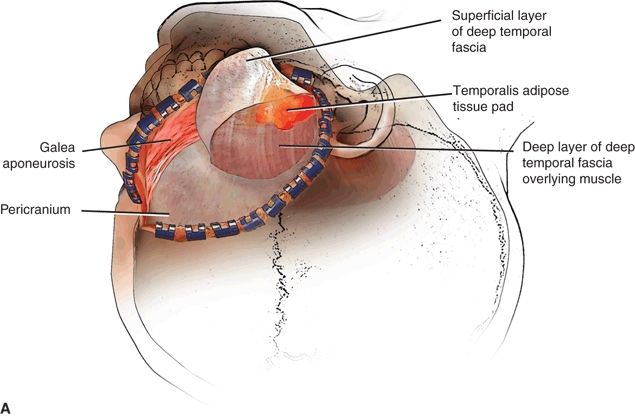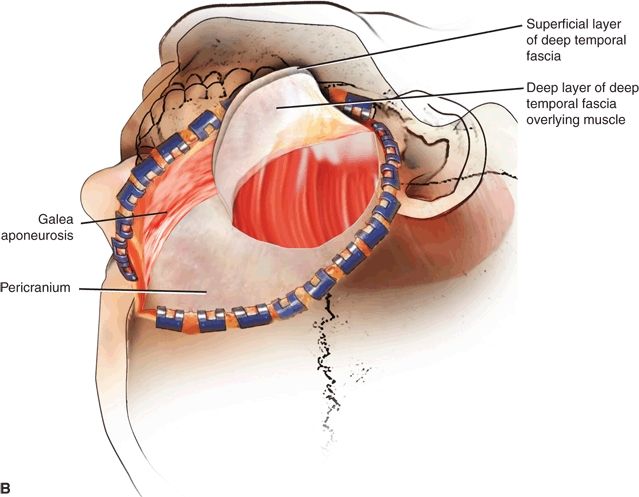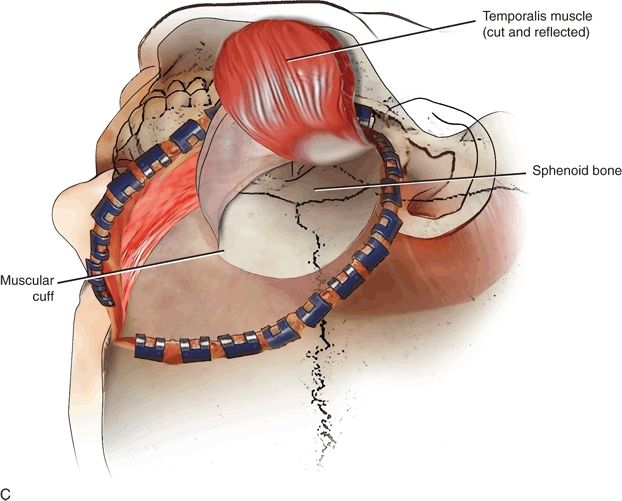FIGURE 48.1 Diagram of the skull indicating the anatomic location of the temporalis muscle.
HISTORY
The temporalis muscle flap is not reliable in the setting of salvage cranial base surgery. The reduced muscle bulk and tenuous blood supply following prior surgery or radiation therapy make the muscle unsuitable in these situations. Therefore, patients should be carefully questioned regarding prior (1) surgical procedure for resection or attempted resection of cranial base tumors, (2) prior chemotherapy or radiation therapy, and (3) prior treatment for intractable epistaxis, which may have required embolization of the internal maxillary artery. In situations of reoperative or salvage surgery, reconstruction with microvascular free tissue transfer from another site should be considered.
Patients should also be questioned regarding prior trauma to the craniofacial skeleton, which may have altered the position of the zygoma or mandible.
PHYSICAL EXAMINATION
The physical examination should be directed at determining the size of the temporalis muscle with particular attention to temporal wasting indicating denervation atrophy. The temporal fossa should be palpated in the neutral position and with the teeth clenched to assess muscle bulk. The range of motion of the mandible should also be determined. Trismus may indicate fibrosis or scarring of the temporalis muscle further limiting its size or arc of rotation into the cranial base defect.
INDICATIONS
The principal indicator for the use of the temporalis muscle flap in cranial base surgery is the reconstruction of the floor of the central skull base following anterior–lateral skull base surgery with subtemporal craniectomy. Resection of neoplasms of the anterior and anterior–lateral cranial base, particularly those requiring a transcranial approach with subtemporal craniotomy, results in exposure of the temporal dura. The removal of bone and soft tissue required by either the surgical approach or the extirpation of the tumor may result in a surgical defect for which primary closure is not possible. Vascularized soft tissue augmentation of the resulting defect is necessary to (1) restore the anatomic separation and immune-competent barrier between the upper aerodigestive tract or paranasal sinuses and the epidural space to prevent meningitis and epidural abscess, (2) provide three-dimensional support and protection to the central nervous system, (3) reduce the probability of cerebrospinal fluid fistula, (4) provide vascular supply to dural reconstruction as needed, (5) enhance functional and aesthetic results by preventing contour deformities in the lateral orbit, and (6) maintain globe position and prevent enophthalmos or dystopia. Other indications for the temporalis muscle flap in extended head and neck and cranial base surgery include support for orbital contents following extended maxillectomy, obliteration of middle ear and mastoidectomy defects following temporal bone resection, and soft tissue augmentation of orbital exenteration defects.
CONTRAINDICATIONS
A common error in using the temporalis muscle is failing to realize the limitations of the size of the flap relative to the defect and not having satisfactory bulk to accomplish the reconstructive goals. Cranial base resection with either orbital exenteration or maxillectomy commonly results in a defect with significant exposure of the temporal lobe dura. This situation is frequently one in which the bulk of the temporalis flap is inadequate to match the defect, and a free tissue transfer is a more appropriate reconstructive option. Another error is not recognizing the need to sacrifice the blood supply to the temporalis muscle during the tumor resection.
PREOPERATIVE PLANNING
Minimal additional preoperative planning is needed when considering using the temporalis muscle for cranial base reconstruction. A detailed history should be obtained regarding previous surgical or nonsurgical treatments of head and neck or skull base malignancy. Prior radiation treatment to this area renders the temporalis muscle flap unreliable, and alternative reconstructive methods should be considered. Standard presurgical imaging of the skull base often includes both CT and MRI studies. The MRI will provide superior detail regarding the size, thickness, and bulk of the temporalis muscle and the potential size of the expected cranial base defect. Dedicated vascular or other specific studies are not necessary prior to using this flap.
SURGICAL TECHNIQUE (FIG. 48.2)



FIGURE 48.2 A-C Interfascial approach and harvest of temporalis muscle.
The successful application of the temporalis muscle flap begins with a clear understanding of the regional anatomy, various investing fasciae, and the vascular supply to the muscle. The temporalis muscle is usually approached through the same incision as the ablative procedure with either a hemi- or bicoronal scalp incision. With a hemicoronal incision, the apex of the incision should be taken to the vertex to expose the ipsilateral pericranium in the event additional tissue is needed in the reconstruction. The inferior aspect of the incision should be carried 1 cm below the tragus to facilitate safe exposure of the zygomatic root and eventually the zygomatic arch. The skin and subcutaneous tissue of the scalp are incised parallel to the hair follicles, and the subgaleal plane is developed anteriorly and posteriorly. Injury to the hair follicles and subsequent permanent alopecia can be avoided by maintaining a plane of dissection deep to the galea or superficial temporal fascia. Bipolar cautery should be used judiciously for hemostasis. The anterior limit of the exposure is the orbital process of the frontal bone and posteriorly the vertical plane of the mastoid tip. The posterior dissection is necessary to mobilize the entire temporalis muscle and gain the maximum arc of rotation.
The temporoparietal fascia (TPF) is attached superiorly to the galea aponeurotic and inferiorly to the superficial muscular aponeurotic system. The TPF is supplied by the frontal and parietal branches of the superficial temporal artery and has been extensively used as both a pedicle flap and a microvascular free tissue transfer for the reconstruction of limited-size head and neck defects. The TPF will need to be divided to fully mobilize the temporalis muscle; therefore, the identification and preservation are critical to maintain the integrity of this flap.
Stay updated, free articles. Join our Telegram channel

Full access? Get Clinical Tree


